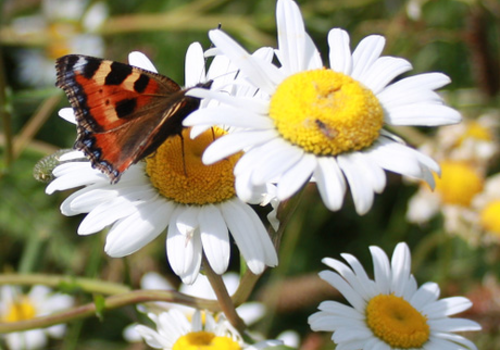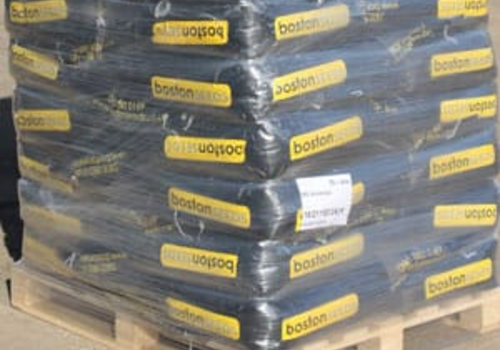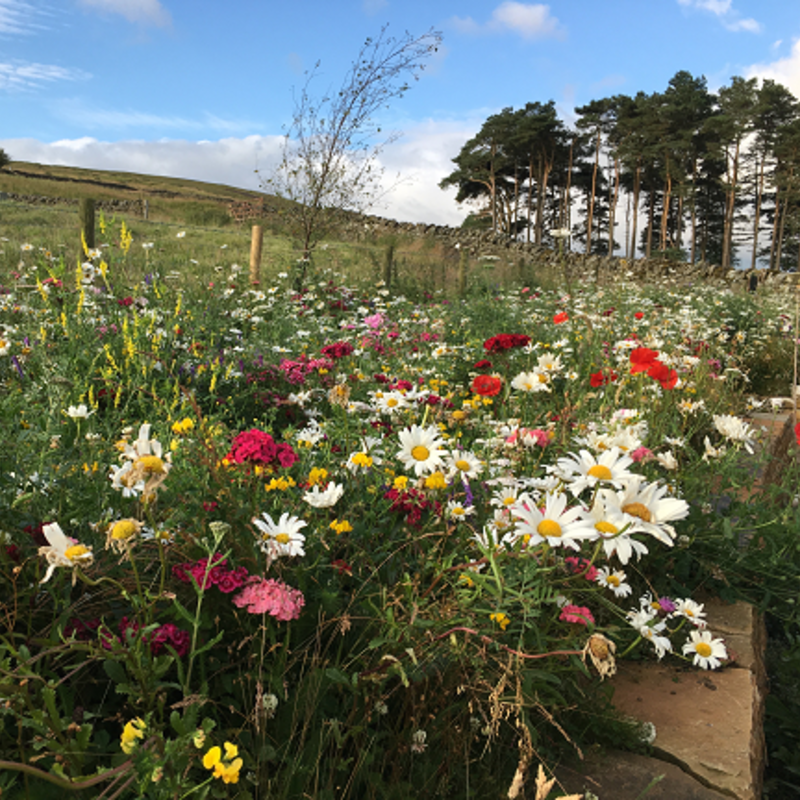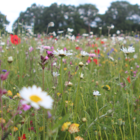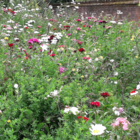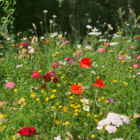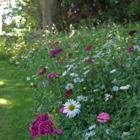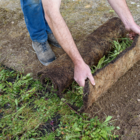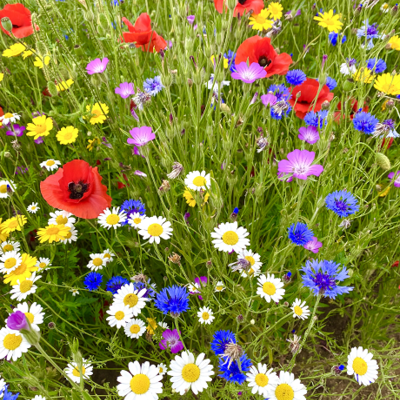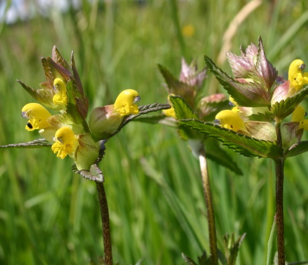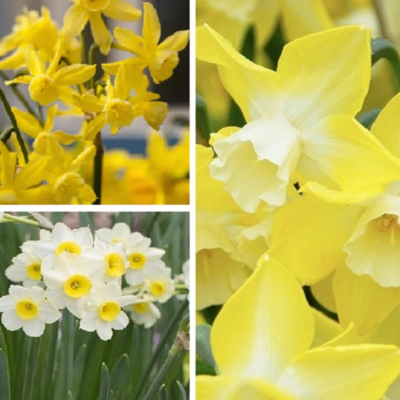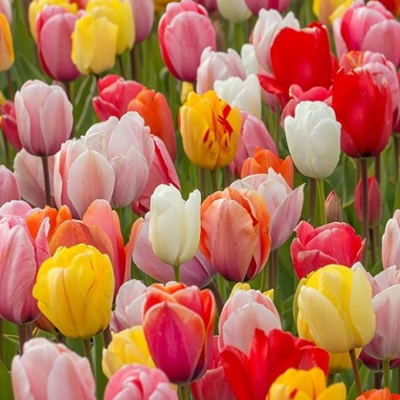Native Enriched Wildflower Turf®
The perfect solution to a guaranteed wildflower meadow! Specifically designed to extend the flowering season, this turf combines UK native species with naturalised wildflowers to provide great colour in all areas! Lifted to order, this turf provides visual interest from early Spring to mid-Autumn, meaning you can get your dream wildflower meadow any time of the year!
- 15% Grass, 85% Flora - 52 wildflower species both native and naturalised
- Extended flowering season
- Creation of a bio-diverse habitat supporting a range of birds, bees and butterflies
- Minimum established height: 30cm. Maximum established height: 75cm
- Typical applications: gardens, parks, private grounds and estates
This turf can be laid at any time of the year, as long as the ground isn’t frozen, ensuring time is on your side when creating the perfect biodiverse habitat!
Our Standard Turf Range has been grown on for 8-12 weeks. For turf that is further along its growing cycle with advanced plant and root development, look towards our Mature Range which has been grown on for a minimum of 20 weeks.
If you have a question about the Native Enriched Wildflower Turf®, head over to our advice page to find out more on how to create your perfect meadow!
Please note that your order will only be delivered from Tuesdays to Thursdays. Due to the nature of Wildflower Turf, it is cut and lifted at the point of order. Therefore, unfortunately, we’re unable to accept any cancellations or returns.
Mixture Specification
Turf size will vary with application but is generally 1m x 0.64m = 0.64m² slabbed or 1.62m x 0.77m = 1.25m² rolled.
| Flora (85%) | ||
| Alpine Forget me Not | (Perennial) | Naturalised |
| Alpine Rock Cress | (Perennial) | Naturalised |
| Autumn Hawkbit | (Perennial) | UK Native |
| Baby's Breath | (Annual) | Naturalised |
| Betony | (Perennial) | UK Native |
| Birdsfoot Trefoil | (Perennial) | UK Native |
| Black Medic | (Perennial) | UK Native |
| Bladder Campion | (Perennial) | UK Native |
| Borage | (Annual) | Naturalised |
| Cat's Ear | (Perennial) | UK Native |
| Common Columbine | (Perennial) | Naturalised |
| Common Corncockle | (Annual) | Naturalised |
| Common Pink | (Perennial) | Naturalised |
| Common Knapweed | (Perennial) | UK Native |
| Common Poppy | (Annual) | Naturalised |
| Common Toadflax | (Perennial) | UK Native |
| Common Vetch | (Perennial) | UK Native |
| Cornflower | (Annual) | Naturalised |
| Cowslip | (Perennial) | UK Native |
| Crimson Clover | (Annual) | UK Native |
| Dames Violet | (Biennial) | Naturalised |
| English Marigold | (Annual) | Naturalised |
| Fenugreek | (Annual) | Naturalised |
| Field Scabious | (Perennial) | UK Native |
| Garden Candytuft | (Annual) | Naturalised |
| Great Large Bellflower | (Perennial) | Naturalised |
| Honesty | (Annual) | Naturalised |
| Horned Pansy | (Perennial) | Naturalised |
| Kidney Vetch | (Perennial) | UK Native |
| Lady's Bedstraw | (Perennial) | UK Native |
| Larkspur | (Annual) | Naturalised |
| Meadow Cranesbill | (Perennial) | UK Native |
| Mountain Madwort | (Perennial) | Naturalised |
| Musk Mallow | (Perennial) | UK Native |
| Nodding Catchfly | (Annual) | Naturalised |
| Oxeye Daisy | (Perennial) | UK Native |
| Perforate St John Wort | (Perennial) | UK Native |
| Perennial Flax | (Perennial) | Naturalised |
| Ragged Robin | (Perennial) | UK Native |
| Red Campion | (Perennial) | UK Native |
| Salad Burnet | (Perennial) | UK Native |
| Self Heal | (Perennial) | UK Native |
| Siberian Wallflower | (Biennial) | Naturalised |
| Strawberry Clover | (Perennial) | UK Native |
| Sweet Willia | (Perennial) | Naturalised |
| Tufted Vetch | (Perennial) | UK Native |
| Vipers Bugloss | (Perennial) | UK Native |
| Wallflower | (Perennial) | Naturalised |
| White Campion | (Perennial) | UK Native |
| Wild Marjoram | (Perennial) | UK Native |
| Wild Red Clover | (Perennial) | UK Native |
| Yarrow | (Perennial) | UK Native |
| Grasses (15%) | ||
| Yellow Oatgrass | ||
| Sweet Vernal Grass | ||
| Quaking Grass |
Sowing & Establishment
How to lay your Wildflower Turf
1 - Delivery
Depending on the time of year, your Wildflower Turf will be delivered on a pallet in either rolls or slabs. The turf should be laid within 24 hours of receiving the delivery to prevent drying out. If this is not viable, remove the turf from the pallet, unroll and keep watered until it’s able to be laid.
2 - Ground Preparation
Ensure any weeds or debris are removed from the area and take it back to bare earth. This can be done by using weedkiller or a plastic sheet.
3- Rotavate the Soil
Rotavate the area to a depth of 10cm to create a fine tilth by using either a rotavator or tiller. If any debris is brought to the surface, remove.
4 - Weed Prevention
Leave the soil fallow after rotavating for 1-2 weeks. Disturbance of the soil during rotavating can cause germination of weeds. Remove these before laying the turf.
5 - Final Ground Preparation
48 hours before turf installation, water the area until saturated.
6 - Turf Installation
Roll/lay out the turf and press into the bare soil to ensure good soil contact, without overlapping the edges. Ensure there are no gaps between edges of the turf as this will promote weed growth. The turf can be cut to fit around any awkward shapes.
7 - Watering
Water the turf after laying and ensure the soil beneath the turf is damp. Water generously in the first couple of weeks to avoid the turf drying out.
8 - Root Establishment
After a couple of days following the turf being laid, slowly lift a corner of the turf up to check the roots are starting to knit into the soil.
Maintenance
1 - Flowering
A unique ‘soil-less’ system, Wildflower Turf will flower within the first year if containing annuals. Perennials in the mix will flower from the second year onwards once the roots are fully established and have gone through a period of vernalisation.
2 - Fertiliser
Wildflowers prefer poorer soil types, so no fertiliser is required before or during establishment.
3 - Leaf Matter
If laying turf under trees, ensure that the leaf matter is removed as this can smother light for the young wildflowers and mulch back into the soil, enriching the area.
4 - Weeding
Gaps between each slab of turf can cause some dormant weed seeds to germinate once given the ideal conditions. Because of this, some common lawn weeds such as trefoil and plantain may appear – the best way to minimize this and remove the vigour is by either pulling them out or spot spraying.
5 - Spring Cut
Suited to an established meadow, an early spring cut (end of February/early March) will help tidy up the area ready for summer flowering. It is recommended not to cut any lower than 10cm as this can disturb the flowers starting to emerge. Remove the clippings after the cut. Cutting can either be done with a strimmer, mower (with the box off) or scythe.
6 - Autumn Cut
An autumn cut is required in order for annuals to self-seed and flower the following year, helping the meadow mature. Once the flowers have died back (around September/October) depending on the season, cut down to around 10cm in height and leave the cuttings on the surface for around 7-10 days. This will allow the seed heads to dry out and for the seed to drop into the soil. After this time, it is important to remove the cuttings to prevent them mulching back into the soil.
Turf Backing
Turf Backing
Why Choose Boston Seeds
Why choose Boston Seeds?
With over two decades of experience, Boston Seeds is a family-run business whose passion lies in creating beautiful outdoor spaces with high-quality lawn grass and wildflower seed mixtures. We stock everything you need to create a beautiful lawn or wildflower meadow, including wildflower turf.
When buying from Boston Seeds, you also get:
- Quality assurance: Each wildflower turf in our range is carefully cultivated and rigorously tested to ensure it thrives in your outdoor space.
- Customer satisfaction: We take pride in providing the best possible service and products for our customers. If you’ve got any questions or concerns our team is always happy to help.
- Expert advice: We are always on hand to help provide advice on caring for your wildflowers to ensure it’s looking great. Take a look at our advice section or get in touch.
- Versatility: Whatever your needs, we’ve got the wildflower turf for you.
How we can help!
We’re passionate about great service and have been helping customers create beautiful lawns and meadows for years. With NextDay Delivery available on hundreds of items, it’s never been easier to transform your space.
With Next Day Delivery on hundreds of items too, choosing from our range of wildflower turf couldn't be easier. Ordering regularly or looking for large volumes? Click here to apply for a trade account today - we review all applications within one working day.
FAQs
What is native enriched wildflower turf?
Native enriched wildflower turf is designed to be more visually striking and offers a wider variety of species than traditional wildflower turf.
Does native enriched wildflower turf need to be cared for differently than regular wildflower turf?
Yes, it requires a bit more attention when laying and during early establishment. Once settled, it’s still relatively low maintenance. Some species may need more specific timing for cutting and care.
When should I lay native enriched wildflower turf?
You can lay wildflower turf all year round as long as the ground isn’t frozen. However, is it best to lay it in the spring or autumn when the conditions are optimal.
Will wildflowers grow back every year?
It depends on the species, but many wildflowers are perennials and will return each year.
Buy With Confidence

